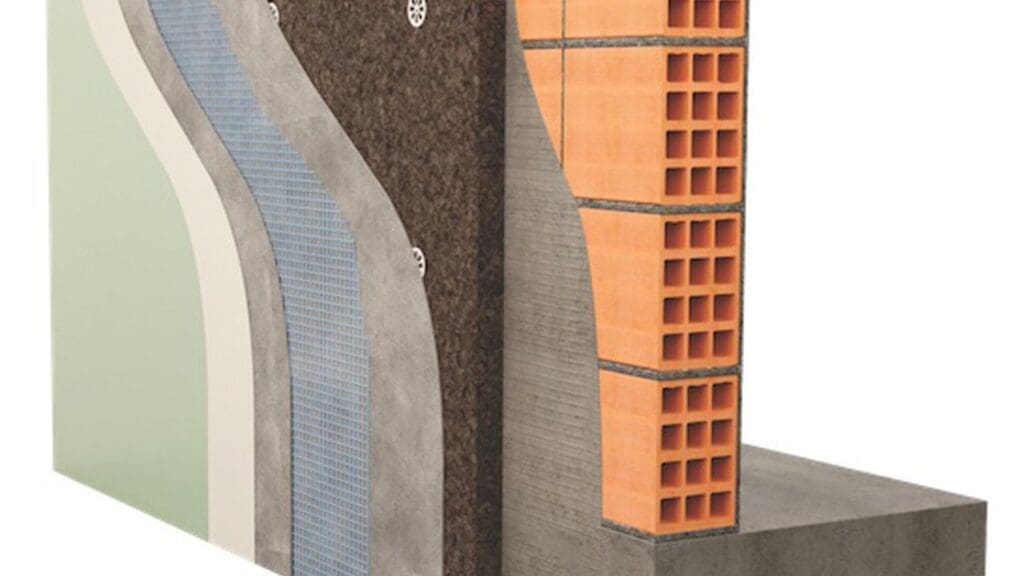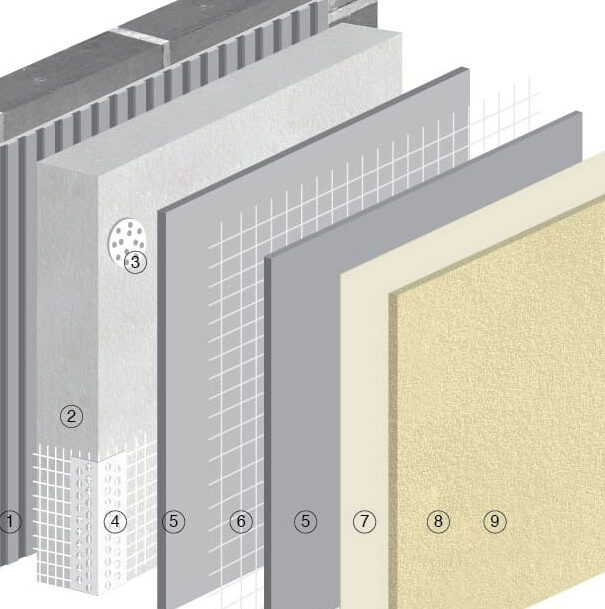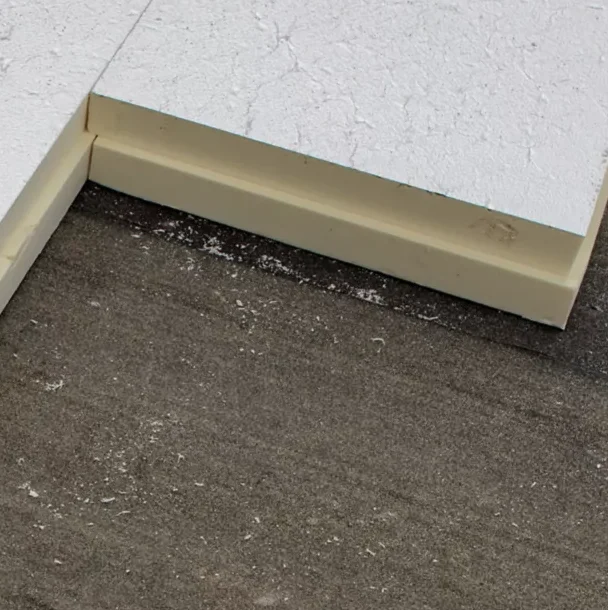Introduction
Choosing the right construction material is critical for cost, energy efficiency, and durability—especially in hot climates like Saudi Arabia, Qatar, the UAE, Oman, Bahrain, and Kuwait. Two popular exterior wall solutions are EIFS System (EIF system or Exterior Insulation and Finish System) and brick block. But which one is cheaper and better suited for the GCC region? Is EIFS Cheaper Than Brick Block?
This article provides a detailed cost comparison between EIFS and brick, exploring installation expenses, energy savings, durability, and overall benefits.
Table of Contents
What Is EIFS, and How Does It Compare to Brick Block?

EIFS is a lightweight, insulated exterior wall system that consists of layers, including:
- A foam insulation board for thermal efficiency
- A base coat with reinforcement for durability
- A finish coat that mimics stone, brick, or other materials
Brick, on the other hand, is a solid masonry material that is highly durable but requires additional insulation to improve energy efficiency.
Key Differences Between EIF Sytem and Brick
| Feature | EIFS | Brick |
|---|---|---|
| Cost | Lower | Higher |
| Installation Time | Faster | Slower |
| Insulation (Energy Savings) | High | Low (without added insulation) |
| Maintenance | Minimal | Requires periodic checks |
| Aesthetic Variety | Customizable | Traditional look |
Why EIFS System Is More Cost-Effective?
Yes, EIFS is cheaper than brick in terms of both material costs and installation expenses. Here’s why:
- Material Cost:
- Brick is more expensive due to raw material and transportation costs.
- EIFS is made of lightweight components, reducing material expenses.
- Labor and Installation Costs:
- Brick requires skilled masons and longer construction times, increasing labor costs.
- EIFS is faster to install, reducing labor expenses by up to 30-50%.
- Project Speed and Cost Efficiency:
- Faster installation = lower overall project cost.
- EIFS allows for quicker completion, ideal for large-scale construction projects in the GCC.
Example:
In Saudi Arabia and the UAE, using exterior insulation and finish system instead of brick can save contractors thousands of dollars in both material and labor costs.

Does EIFS Reduce Energy Costs Compared to Brick?
Yes. EIFS provides better thermal insulation, reducing cooling costs by up to 40% in hot climates like Riyadh, Dubai, and Doha.
- EIFS acts as a thermal barrier, preventing heat absorption.
- Brick absorbs heat, increasing the need for air conditioning.
Energy Efficiency Comparison
| Factor | EIFS | Brick |
|---|---|---|
| Heat Absorption | Low | High |
| Cooling Cost Savings | Up to 40% | Minimal |
| Thermal Insulation | High | Requires extra layers |
In GCC countries, where temperatures exceed 45°C in summer, EIFS can significantly reduce electricity bills.
Which Material Is Easier to Install: EIFS or Brick?
EIFS is much easier to install than brick. It requires less labor and equipment, allowing for faster project completion. In contrast, brick installation is labor-intensive, requiring skilled masons and longer construction times.
Why Is EIFS Installation Faster?
Simpler Installation Process
EIFS involves pre-manufactured insulation panels applied in layers, whereas brick requires bricklaying, mortar drying, and structural reinforcement.
Fewer Construction Stages:
- EIFS requires fewer labor-intensive steps.
- Brick walls need mortar setting time and structural adjustments.
Lighter Weight:
- EIFS does not require the same heavy-duty structural support as brick.
- Brick can increase foundation and structural costs, leading to longer construction timelines.
Example:
A 50,000 sqm commercial project in Doha or Abu Dhabi can be completed weeks faster using EIFS instead of brick.

Does EIFS or Brick Last Longer?
- Brick lasts over 100 years but needs maintenance (e.g., repointing, waterproofing).
- EIFS lasts 50+ years with minimal upkeep if properly installed.
In humid climates like Oman and Bahrain, brick can degrade faster due to moisture absorption, while EIFS resists water infiltration.
Maintenance Needs
| Factor | EIFS | Brick |
|---|---|---|
| Lifespan | 50+ years | 100+ years |
| Water Resistance | High | Low (prone to water damage) |
| Cracking Risk | Low | Can crack over time |
For long-term projects in the GCC, EIFS is a low-maintenance solution compared to brick.
Is EIFS Suitable for Luxury Projects in the GCC?
Yes! EIFS offers customizable finishes, allowing architects to mimic:
- Marble
- Stone
- Traditional brick aesthetics
This makes EIFS ideal for luxury villas, hotels, and commercial buildings in Dubai, Riyadh, and Doha.
EIFS vs. Brick for High-End Projects
| Feature | EIFS | Brick |
|---|---|---|
| Customizable Designs | Yes | Limited |
| Premium Finishes | Yes | Traditional look only |
| Weight Considerations | Lightweight | Heavy (requires structural support) |
For projects in Saudi Arabia, Qatar, and the UAE, EIFS provides a modern, elegant look while reducing costs.
Forma Insulation: Your Trusted EIFS Supplier in GCC
Forma Insulation is proud to offer superior EIFS system supplies to our customers in the GCC region at GREAT PRICES! As the largest EPS polystyrene manufacturer in the GCC, we ensure that our EIFS systems are of the highest quality, providing exceptional thermal insulation and durability for all types of projects.

Conclusion: Which One Should You Choose?
For construction projects in Saudi Arabia, Qatar, the UAE, Oman, Bahrain, and Kuwait, EIFS is the more cost-effective, energy-efficient, and versatile choice.
| Factor | EIFS | Brick |
|---|---|---|
| Cheaper Overall Cost | ✅ | ❌ |
| Energy Savings | ✅ | ❌ |
| Faster Installation | ✅ | ❌ |
| Custom Design Options | ✅ | ❌ |
Final Recommendation
- Choose EIFS if you want lower costs, faster installation, and energy savings.
- Choose brick if you prefer traditional aesthetics and long-term durability.
- For GCC construction projects, EIFS is the better investment.

